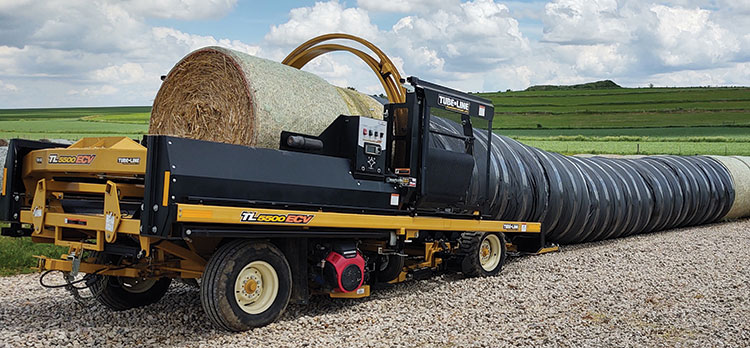Hay moisture at wrapping affects quality |
| By Hay and Forage Grower |
|
|
|
Hay & Forage Grower is featuring results of research projects funded through the Alfalfa Checkoff, officially named the U.S. Alfalfa Farmer Research Initiative, administered by National Alfalfa & Forage Alliance (NAFA). The checkoff program facilitates farmer-funded research.  Kevin Shinners Funding $41,714 Shinners and colleagues wanted to compare whether wrapping dry hay bales with breathable film when using a tube wrapper would help maintain bale forage quality. Breathable film allows water vapors to escape from bales but sheds liquid water on bales. Its technology is used on specific commercial hay balers to wrap individual bales, but it has not been used after baling using a tube wrapper. The researchers hoped the tube wrapper-breathable film combination would lower wrapping costs and reduce the amount of spoilage currently seen with plastic wraps. Breathable film did reduce condensation on bales as compared to stretch plastic films, but changes to the breathable film and tube wrapper would be needed to make the system a workable option. Moisture matters “What made the difference (in forage quality) was the moisture content of the bales that were wrapped,” Shinners explained. “If it wasn’t lower than 20%, we got a lot of condensation and spoilage on the bale surface. When we had that 16%, 17%, or 18% moisture content, we didn’t see condensation and spoilage. The number of layers of wrap made no difference and the color of the wrap made no difference in terms of condensation and spoilage.” “Obviously, four layers are going to be less costly than eight, so producers might consider using only four layers,” he added. “And black films did tend to heat the outer layer of hay and caramelize it a bit, but it was such a thin layer that I’m not sure it’s important. Since the results did not show differences, producers can use any color wrap or number of layers with confidence that the hay will conserve as long as the bale moisture content is less than about 18%.” Breathable film doesn’t have stretchable properties, so researchers modified the wrapper by adding elastic cords to hold the film to bales and tape dispensers to seal the film seams. The researchers, including UW ag engineers Matthew Digman and Joshua Friede and then-graduate student David Pintens, conducted two experiments on first- and second-cutting alfalfa. In both cuttings, samples were taken to determine moisture content and later analyze constituent composition. All bales were weighed and measured. Seven treatments were investigated. Shinners’ team compared bales wrapped in three layers of breathable film, in four and eight layers of white stretch film and black stretch film, as well as bales unwrapped and stored outdoors on a rock pad and unwrapped and stored inside an open-front hay shed. First-cutting bales were stored 148 days; second-cutting bales were stored 97 days. They were weighed, measured, and sampled, and final bale moisture and dry matter content were determined. First-cutting results showed no statistical differences among treatments in dry matter (DM) loss during storage, although stretch plastic film-treated bales had significantly greater moisture content than did breathable film bales or those left unwrapped. Little spoilage was seen on any treatments of second-cutting bales coming out of storage. “If you think the weather won’t allow you to get hay down into those mid- to low teens, why not bale it up into 35%, 40%, or 45% moisture content and make baleage?” Shinners questioned. “If you wanted to sell hay and preserve it, and you could get it below that 17% moisture content range, then wrapping it in film will preserve it, and it’ll make it a better looking bale coming out for sale.”  Dry alfalfa bales wrapped in breathable film reduced bale condensation as compared to bales wrapped in stretch plastic film with an in-line tube bale wrapper. To make the use of breathable film on tube wrappers practical, changes in wrapper design and in the breathable film itself would be needed. Project results 1. A conventional in-line tube bale wrapper was modified so breathable film could be applied to dry alfalfa bales. 2. Neither plastic film color nor the number of layers made a significant difference in storage conservation. Breathable film had less surface spoilage than bales wrapped in plastic film. 3. An initial bale moisture of 16% to 18% going into storage promoted good conservation of wrapped dry bales without surface spoilage. This article appeared in the November 2021 issue of Hay & Forage Grower on pages 28 and 29. Not a subscriber? Click to get the print magazine. |
